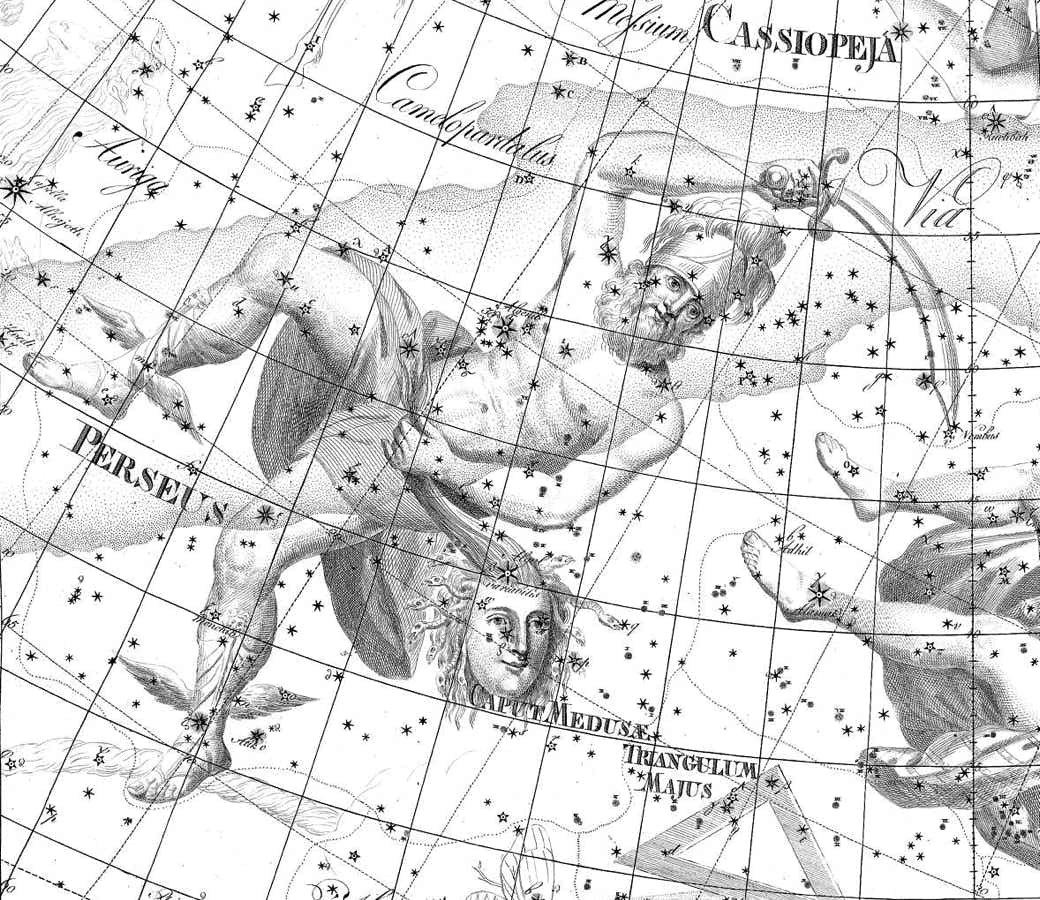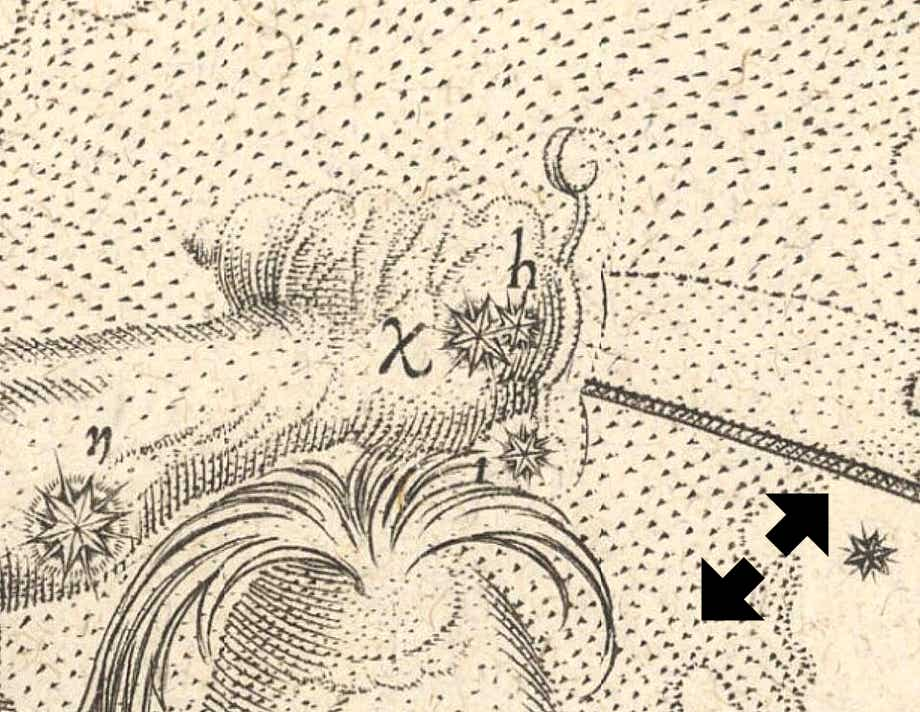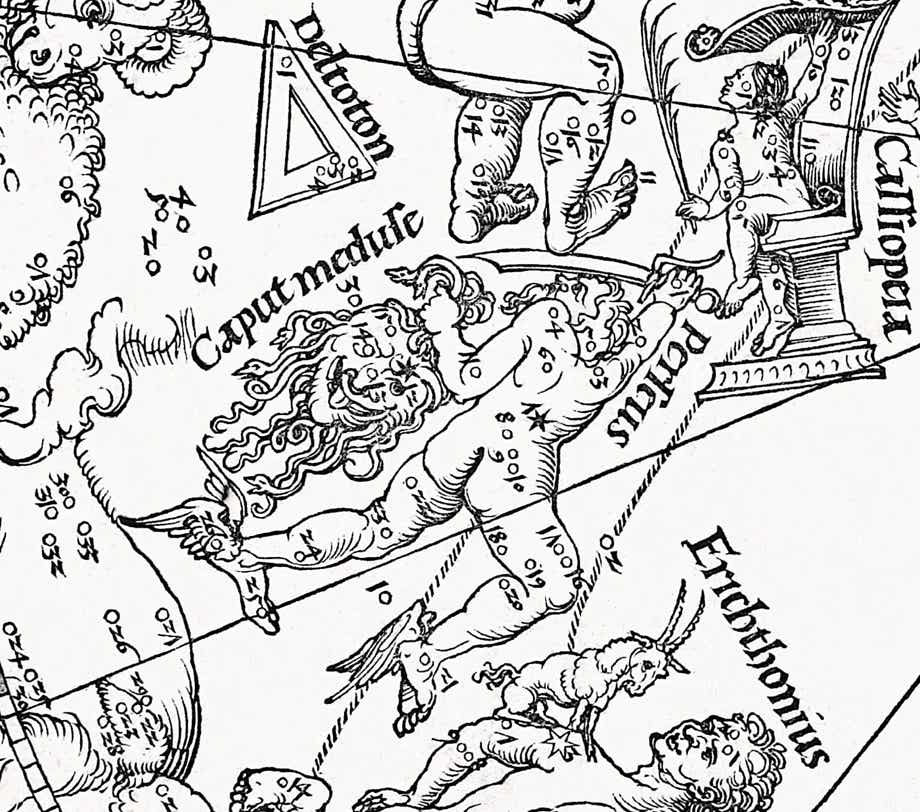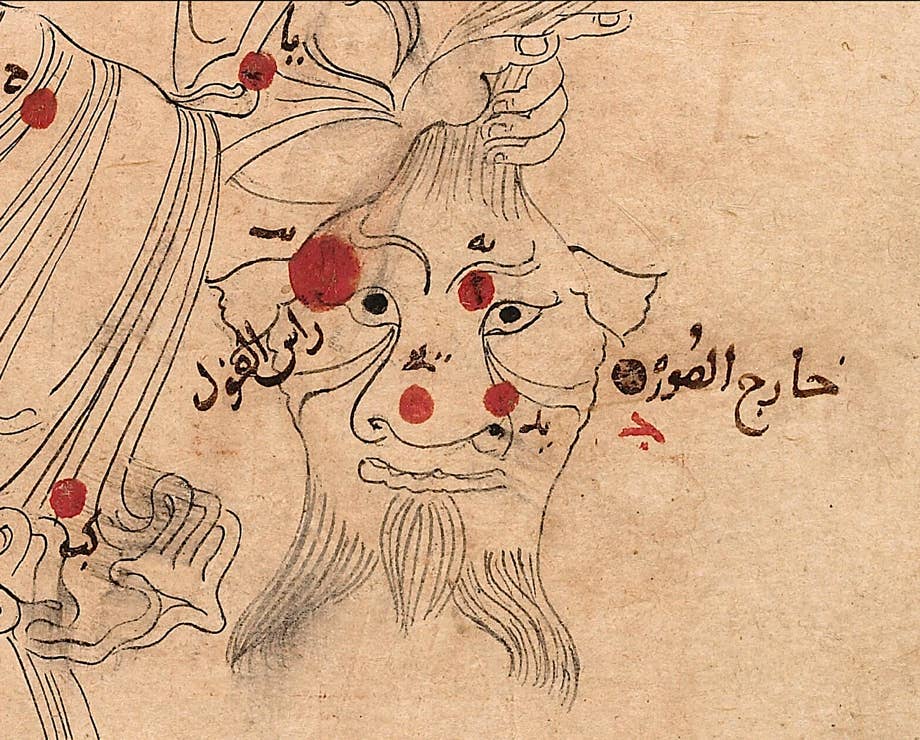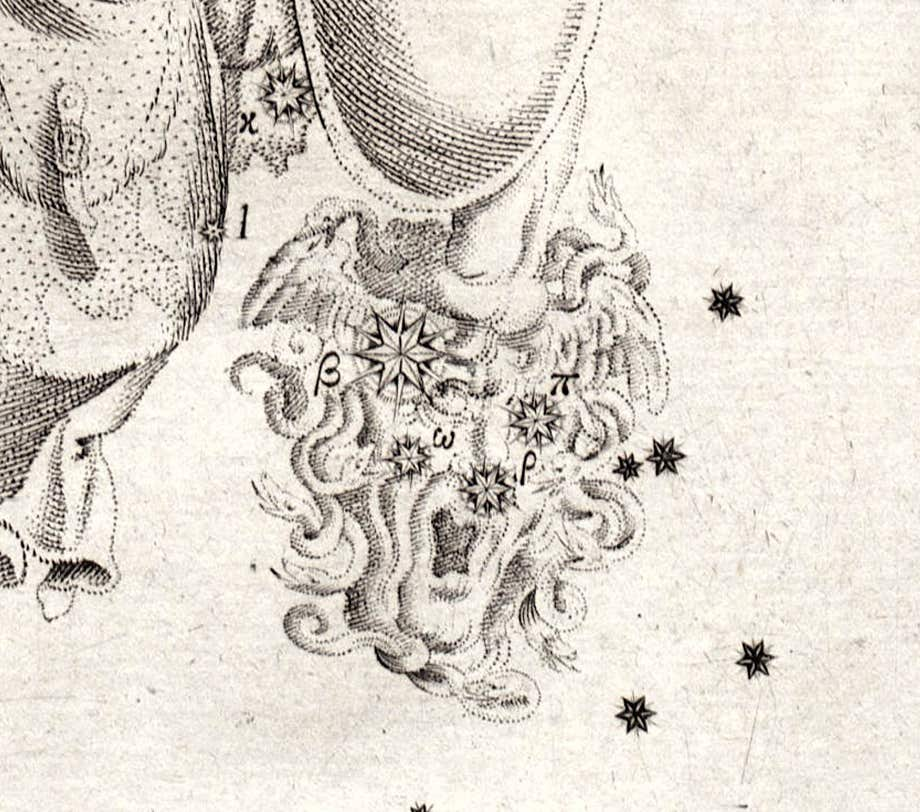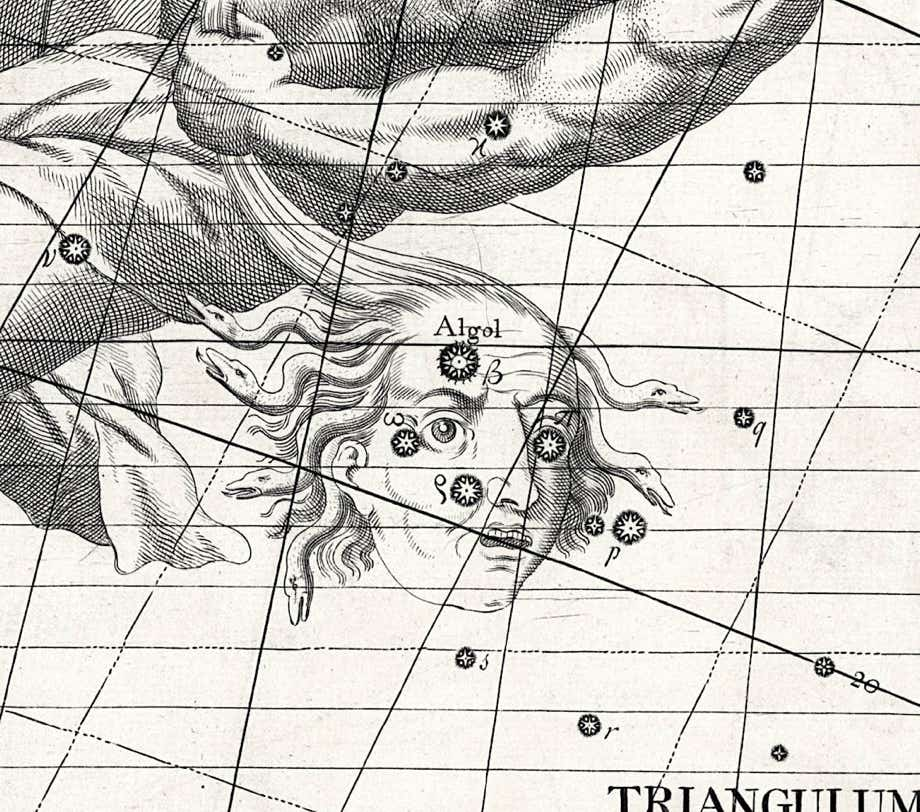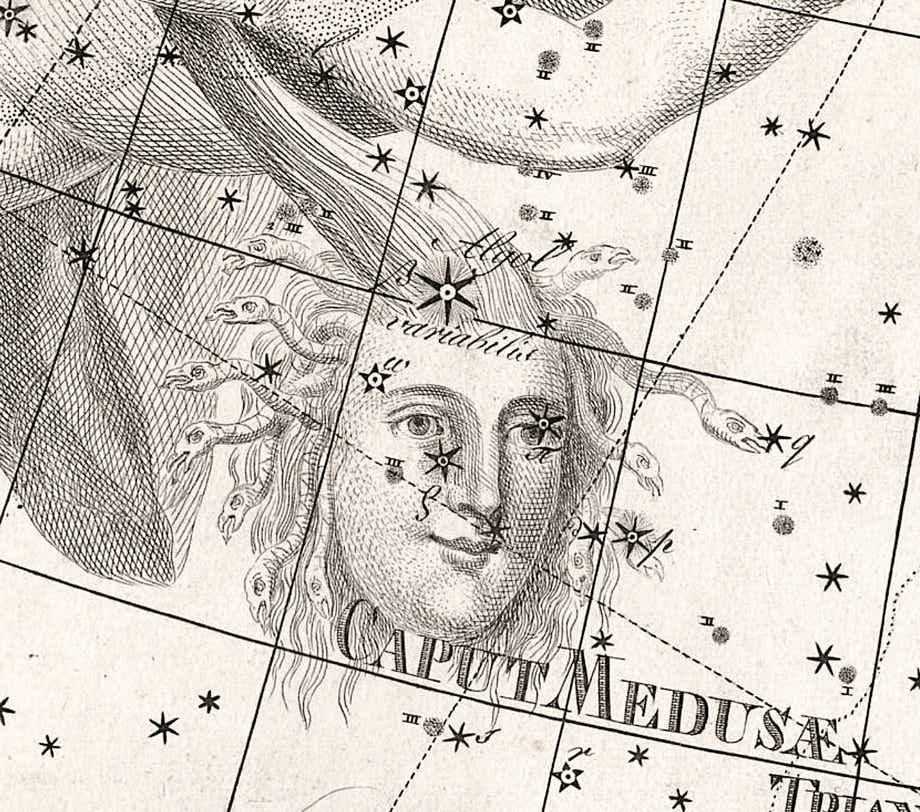
Genitive: Persei
Abbreviation: Per
Size ranking: 24th
Origin: One of the 48 Greek constellations listed by Ptolemy in the Almagest
Greek name: Περσεύς
Perseus (Περσεύς in Greek) is one of the most famous Greek heroes. The characters in his story are represented by six constellations that occupy a substantial part of the sky. The constellation depicting Perseus lies in a prominent part of the Milky Way, which is perhaps why Aratus termed him ‘dust-stained’.
In Greek myth, Perseus was the son of Danaë, daughter of King Acrisius of Argos. Acrisius had locked Danaë away in a heavily guarded dungeon when an oracle foretold that he would be killed by his grandson. But Zeus visited Danaë in the form of a shower of golden rain that fell through the skylight of the dungeon into her lap and impregnated her. When Acrisius found out, he locked Danaë and the infant Perseus into a wooden chest and cast them out to sea.
Inside the bobbing chest Danaë clutched her child and prayed to Zeus for deliverance from the sea. A few days later, the chest washed ashore on the island of Seriphos, its cargo still alive but starved and thirsty. A fisherman, Dictys, broke the chest open and found the mother and child. Dictys brought up Perseus as his own son.
The brother of Dictys was King Polydectes, who coveted Danaë as a wife. But Danaë was reluctant and Perseus, now grown to manhood, defended her from the king’s advances. Instead, King Polydectes hatched a plan to get rid of Perseus. The king pretended he had turned his attentions to Hippodameia, daughter of King Oenomaus of Elis. King Polydectes asked his subjects, including Perseus, to provide horses for a wedding present. Perseus had no horse to give, nor money to buy one, so Polydectes sent him to bring the head of Medusa the Gorgon.
Perseus holding the decapitated head of Medusa the Gorgon, as depicted on
Chart IV in the Uranographia of Johann Bode (1801). On the forehead of the
Gorgon lies the star Algol (Beta Persei), famous for its variations in light.
Perseus and Medusa the Gorgon
The Gorgons were three hideously ugly sisters called Euryale, Stheno, and Medusa. They were the daughters of Phorcys, a god of the sea, and his sister Ceto. The Gorgons had faces covered with dragon scales, tusks like boars, hands of brass, and wings of gold. Their evil gaze turned to stone anyone who set eyes on them. Euryale and Stheno were immortal, but Medusa was mortal. She was distinguishable from the others because she had snakes for hair. In her youth Medusa had been famed for her beauty, particularly that of her hair, but she was condemned to a life of ugliness by Athene in whose temple she had been ravished by Poseidon.
A Gorgon’s head would be a powerful weapon for a tyrannical king to enforce his rule, but King Polydectes probably thought that Perseus would die in his attempt to obtain it. However, the king had reckoned without Perseus’s family connections among the gods. Athene gave him a bronze shield which he carried on his left arm, while in his right hand he wielded a sword of diamond made by Hephaestus. Hermes gave him winged sandals, and on his head he wore a helmet of darkness from Hades that made him invisible.
Perseus beheads Medusa
Under the guidance of Athene, Perseus flew to the slopes of Mount Atlas where the sisters of the Gorgons, called the Graeae, acted as lookouts. The Graeae were poorly qualified for the task, since they had only one eye between the three of them, which they passed to each other in turn. Perseus snatched the eye from them and threw it into Lake Tritonis.
He then followed a trail of statues of men and animals who had been turned to stone by the gaze of the Gorgons. Unseen in his helmet of invisibility, Perseus crept up on the Gorgons and waited until night when Medusa and her snakes were asleep. Looking only at her reflection in his brightly polished shield, Perseus swung his diamond sword and decapitated Medusa with one blow. As Medusa’s head rolled to the ground, Perseus was startled to see the winged horse Pegasus and the armed warrior Chrysaor spring fully grown from her body, the legacy of her youthful affair with Poseidon. (Pegasus is commemorated in a constellation of its own.) Perseus rapidly collected up Medusa’s head, put it in a pouch and flew away before the other Gorgons awoke.
Drops of blood fell from the head and turned into serpents as they struck the sands of Libya below. Strong winds blew Perseus across the sky like a raincloud, so he stopped to rest in the kingdom of Atlas. When Atlas refused him hospitality, Perseus took out the Gorgon’s head and turned him into the range of mountains that now bear his name.
Perseus rescues Andromeda
The following morning Perseus resumed his flight with new vigour, coming to the land of King Cepheus whose daughter Andromeda was being sacrificed to a sea monster. Perseus’s rescue of the girl, one of the most famous themes of mythology, is told in detail under the entry for Andromeda. Perseus returned triumphantly with Andromeda to the island of Seriphos, where he found his mother and Dictys sheltering in a temple from the tyranny of King Polydectes. Perseus stormed into the king’s palace to a hostile reception. Reaching into his pouch, Perseus brought out the head of Medusa, turning Polydectes and his followers to stone. Perseus appointed his stepfather Dictys king of Seriphos. Athene took the head of Medusa and set it in the middle of her shield.
Incidentally, the prophecy that had started all these adventures – namely, that Acrisius would be killed by his grandson – eventually came to pass during an athletics contest when a discus thrown by Perseus accidentally hit Acrisius, one of the spectators, and killed him. Perseus and Andromeda had many children, including Perses, whom they gave to Cepheus to bring up. From Perses, the kings of Persia were said to have been descended.
Algol the Demon and the head of Medusa
In the sky, Perseus lies next to his beloved Andromeda. Nearby are her parents Cepheus and Cassiopeia, as well as the monster, Cetus, to which she was offered in sacrifice. Pegasus the winged horse completes the tableau. Perseus himself is shown grasping the Gorgon’s head by the hair with his left hand. In his right, he holds aloft his star-whetted sword, sometimes depicted as a curving scimitar.
Ptolemy described four stars as lying in the Gorgon’s head; we know them as Beta, Omega, Rho, and Pi Persei. Several map-makers in the 16th to 19th centuries made these and surrounding stars into a sub-constellation, Caput Medusae, the head of Medusa. Albrecht Dürer gave it a separate label on his chart of 1515, as did Bode on his Uranographia atlas (see illustration above).
The star that Ptolemy called ‘the bright one in the Gorgon head’ is Beta Persei, now named Algol from the Arabic ra’s al-ghūl meaning ‘the demon’s head’. Algol is the type of star known as an eclipsing binary, consisting of two close stars that orbit each other, in this case every 2.9 days. Algol varies in brightness from magnitude 2.1 to 3.4 as the two stars eclipse each other. Its variability was first reported in 1671 by the Italian astronomer Geminiano Montanari (1633–87), although it was not until 1783 that its periodicity was established by the English amateur astronomer John Goodricke (1764–86). Arab astronomers knew this constellation both as Barshāūsh, an attempt to transliterate the name Perseus into Arabic, and Ḥāmil ra’s al-ghūl, ‘bearer of the demon’s head’, so it is clear that they were familiar with Greek mythography.
It is sometimes speculated that the name Algol arose because the Arabs knew of its variability, but in fact the name has its origins in Greek mythology and its variability is simply coincidence. The Arabic astronomer al-Ṣūfī, who paid more attention to star brightnesses than had Ptolemy, made no mention of any variability in his Book of the Fixed Stars published in AD 964. The sketch of the constellation in his book places Algol next to Medusa’s eye, not actually on it, and Bayer did the same; many later cartographers, including Flamsteed and Bode, positioned the star even higher on the forehead. The idea of Algol being a ‘winking eye’ seems to be a modern myth.
The brightest star in the constellation, second-magnitude Alpha Persei, is officially named Mirfak, which comes from the Arabic for ‘elbow’, mirfaq. A former alternative name was Algenib from the Arabic al-janb meaning ‘the side’, which is where Ptolemy described it as lying; however, that name is now officially assigned to Gamma Pegasi. It lies at the centre of a loose scattering of stars known as the Alpha Persei Cluster.
The Double Cluster
The right hand of Perseus, in which he holds his sword, is marked by a feature that Ptolemy in the Almagest termed a ‘nebulous mass’. This ‘nebulous mass’ is, in fact, a twin cluster of stars now popularly called the Double Cluster. The individual clusters are often known as h and Chi (χ) Persei, the designations they were given by Johann Bayer in his Uranometria atlas and catalogue of 1603 (see illustration). Flamsteed and Bode labelled the pair simply as Chi, but it is Bayer’s designations that have stuck. The cluster was known to ancient Arab astronomers, for whom it marked the tail of the smaller member of a pair of fish that they visualized in this area. For more on the Arabic depiction of the Double Cluster see this separate page.
The Double Cluster, as shown on the Uranometria atlas of Johann Bayer (1603),
who designated the clusters h and Chi (χ) Persei. They are now also known by the
catalogue numbers NGC 869 and NGC 884
Chinese associations
In Chinese astronomy, the arc of nine stars from Eta and Gamma Persei in the north via Alpha and Delta then heading to Mu and into Camelopardalis formed the constellation Tianchuan, a boat in the river of the Milky Way. According to one interpretation, it was a military vessel for the Great General of Heaven, Tian Dajiangjun, who was represented by Gamma Andromedae and neighbouring stars. Lambda Persei, the star within the arc of Tianchuan, was called Jishui, representing a build-up of water in the bilges of the boat.
A fainter arc of eight stars from either 11 or 9 Persei in the north via Tau, Iota, Kappa, Beta (Algol), Rho, and 16 to 12 Persei formed Daling, a large tomb or mausoleum. The star within this arc, Pi Persei, was called Jishi, referring to a pile of dead bodies in the mausoleum. (R. H. Allen wrongly identified Jishi as Algol in his book Star Names.) In the south of the present-day constellation the hook-shaped group of six stars from Nu and Epsilon to Omicron and 40 Persei formed Juanshe, representing a curled tongue. One star within the arc, 42 Persei, was called Tianchan, referring to slander and gossip, presumably spread by the wagging tongue.
© Ian Ridpath. All rights reserved
Albrecht Dürer showed the snake-haired head of Medusa as a sub-constellation under the name Caput Meduse (sic) on his northern celestial hemisphere chart of 1515. The stars are numbered in the order they were listed in Ptolemy’s Almagest. Star 12, on Medusa’s forehead, is the one we now know as Algol. Dürer drew the constellations in reverse, as they would appear on a celestial globe.
Algol was positioned on the side of Medusa’s severed head in this depiction from al-Ṣūfī’s Book of the Fixed Stars. Here the head of Medusa has become a bearded man, perhaps because the Arabs had seen western depictions of Medusa’s head known as gorgoneia and misinterpreted the Gorgon’s dangling snake hair as a beard.
Johann Bayer showed Algol on the right of Medusa’s forehead, not on the eye, in his Uranometria star atlas of 1603. On this chart Bayer gave it the Greek letter Beta, by which we still know it today.
In John Flamsteed’s Atlas Coelestis of 1729, Algol was placed high on the forehead of the decapitated Medusa, above her right eye. Flamsteed did not mention the star’s variability as this was still over half a century before Goodricke’s discovery of its periodicity.
Johann Bode placed Algol in the hair of Medusa on his Uranographia star atlas of 1801. He added the word ‘variabilis’ to denote its variability in brightness, which had been established to be periodic less than 20 years earlier. Bode’s Medusa was serenely beautiful, unlike the gruesome face of most depictions.


